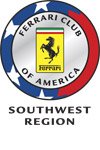
Oldtimer's Corner - Tony Parravano
By Ed Niles
When I returned from that grand week in Monterey (and wasn?t it a Grand week?!), I found a phone message from Ron Parravano. It turns out that Ron, an attorney in Carmel, is the son of Tony Parravano, a colorful figure among a cast of colorful characters in sports car racing in the mid 50?s. Ron explained to me that he had been talking with Peter Sachs, owner of the magnificent 121LM which had been owned by Tony Parravano, and that Peter had given him my name. Ron said that some day he hopes to write a book about his father?s life.
Ron?s call brought back such a flood of memories that I thought it might be worth sharing a few of them here.
When World War II ended in 1948, the country was literally starving for many things: gasoline and tires has been strictly rationed, there were no civilian automobiles being sold, an acute housing shortage was developing, and many food items had been unobtainable for several years.
In the late 40?s, there were enough sports car enthusiasts that the Sports Car Club of America (SCCA) was able to begin promoting a series of sports car races. The leaders of this organization, known in the press as "The Westport Pharaohs," felt strongly that the entrants of these races should be "Sportsman owner-drivers." In other words, any hint of commercialism was abhorrent. On the left coast, however, there was a different feeling, and gradually the California Sports Car Club ("Cal Club") took over the majority of the races. This climate was made to order for wealthy individuals who could afford to buy the latest Ferraris and had the best drivers. John Von Neumann and John Edgar both owned small stables of Ferraris, sometimes running several of their cars in the same races. But none burst onto the scene so spectacularly, and certainly none disappeared so mysteriously, as Tony Parravano. Who was this man?
I first met Jack McAfee around 1949, when I was courting my first serious girlfriend, and Jack was calling on her older sister. I remember being quite impressed that he would arrive in what we would now call a "T-Bucket Roadster," and he was barely 17. After the war ended, Jack had his own shop, and one of the cars he took care of was a Cadillac (a 1949 Sedanette, if memory serves) owned by Tony Parravano. Jack persuaded Tony to let him run the car in the Mexican Road Race, and Tony was bitten by the racing bug. Later, Tony bought a Ferrari 340 America Ghia Coupe (s/n 0150AM) which Jack drove to a 5th overall in the 1953 Mexican Road Race. The car was essentially as delivered from the factory, although Jack added a small louver at the front of each rear fender, to aid in the rear brake cooling, and mounted Halibrand magnesium wheels. Jack also drove the car, with some success, at local venues such as Torrey Pines.
Tony Parravano, dark, short and slightly built, had arrived in Southern California after the war from Chicago, with "mysterious sources of funds." Southern California writers have always been fascinated by tales of the mob, since it never really got a strong foothold here, so many people were quick to put his Chicago roots together with his Italian-sounding name, and reached conclusions which may or may not have been correct. In any event, Tony was obviously a guy who was highly motivated and was not afraid of success on a grand scale. His first major venture was in frozen foods, a concept that was just a bit before its time. After that misadventure, he began building tract homes around the suburbs of Los Angeles. Already, he had focused on two of the things which Southern California was most starved for: food and housing. And his hobby involved the third element - automobiles.
Apparently, he did well as a building contractor; how could he not, when new homes were selling like the proverbial hot cakes? In an article in Sport Cars Illustrated in 1957, Pa
For a complete look at Sempre Ferrari, you may want to check out the rest of the articles from Volume 2, Issue 1 - January 1995
